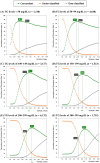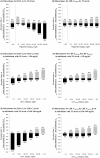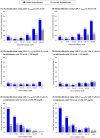Refining the Martin-Hopkins method for estimating low-density lipoprotein cholesterol levels: Median versus optimal TG/VLDL-C ratio
- PMID: 40608775
- PMCID: PMC12225850
- DOI: 10.1371/journal.pone.0327169
Refining the Martin-Hopkins method for estimating low-density lipoprotein cholesterol levels: Median versus optimal TG/VLDL-C ratio
Abstract
Background: Low-density lipoprotein cholesterol (LDL-C), a major modifiable risk factor for cardiovascular diseases, is typically calculated using the Friedewald formula when triglyceride (TG) levels are below 400 mg/dL. Recent studies have demonstrated the superior accuracy of the Martin-Hopkins method across diverse populations. While this method estimates very-low-density lipoprotein cholesterol (VLDL-C) using strata-specific median TG/VLDL-C ratios, its reliance on median statistics raises questions about whether these ratios are truly optimal.
Objectives and methods: This study evaluated the performance of the Martin-Hopkins method compared to the Friedewald formula, focusing on its potential for improvement by applying optimal TG/VLDL-C ratios. Using data from 18,322 individuals in the Korea National Health and Nutrition Examination Survey (KNHANES), we derived strata-specific optimal TG/VLDL-C ratios designed to maximize concordance with directly measured LDL-C values, based on LDL-C categories defined by clinical guidelines. We compared the performance of four LDL-C estimation models: the Friedewald formula (LDL-CF), the original Martin-Hopkins method (LDL-CM-N), and two alternative models that applied TG/VLDL-C ratios derived from our data-one using median values (LDL-CKM-N) and the other using optimal values tailored to each stratum (LDL-CKO-N).
Results: The Martin-Hopkins method showed significantly higher concordance than the Friedewald formula for TG levels < 400 mg/dL (79.6% for LDL-CF vs. 83.2% for LDL-CM-180, p < 0.001). Concordance improved by less than 2% for TG levels < 150 mg/dL (83.3% vs. 84.9%), but by approximately 10% for TG levels of 150-399 mg/dL (68.8% vs. 78.0%). The largest discrepancy was observed in classifying LDL-C levels < 70 mg/dL among individuals with TG levels of 150-399 mg/dL (47.5% for LDL-CF vs. 90.3% for LDL-CM-180). However, the overall concordance differed only modestly between the 10-cell and 180-cell Martin-Hopkins equations (82.8% for LDL-CM-10 vs. 83.2% for LDL-CM-180, a difference of 0.4%), indicating only a marginal benefit despite the substantial increase in the number of strata. Using optimal TG/VLDL-C ratios increased overall concordance compared to median ratios within the same stratification, with LDL-CKO-N estimates outperforming their LDL-CKM-N counterparts. However, this improvement was not statistically significant in LDL-C estimates derived from TG-only stratification.
Conclusions: Applying optimal TG/VLDL-C ratios within the Martin-Hopkins method improves accuracy compared to median ratios, particularly when stratifications incorporate both TG and non-high-density lipoprotein cholesterol (non-HDL-C) levels. This enhancement can be achieved without increasing the number of strata, offering a practical pathway to refine LDL-C estimation while avoiding excessive stratification. Our findings suggest that while median statistics may be sufficient for TG-only stratifications, they do not fully capture optimal TG/VLDL-C ratios for combined TG and non-HDL-C stratifications.
Copyright: © 2025 Lee et al. This is an open access article distributed under the terms of the Creative Commons Attribution License, which permits unrestricted use, distribution, and reproduction in any medium, provided the original author and source are credited.
Conflict of interest statement
The authors have declared that no competing interests exist.
Figures







Similar articles
-
Comparison of the accuracy of the Friedewald, Martin, and Sampson formulas to estimate very low levels of low-density lipoprotein cholesterol.Endokrynol Pol. 2023;74(2):203-210. doi: 10.5603/EP.a2023.0025. Endokrynol Pol. 2023. PMID: 37155302
-
Quality improvement strategies for diabetes care: Effects on outcomes for adults living with diabetes.Cochrane Database Syst Rev. 2023 May 31;5(5):CD014513. doi: 10.1002/14651858.CD014513. Cochrane Database Syst Rev. 2023. PMID: 37254718 Free PMC article.
-
A Modified Sampson-NIH Equation with Improved Accuracy for Estimating Low Levels of Low-Density Lipoprotein-Cholesterol.Clin Chem. 2025 Jul 9:hvaf073. doi: 10.1093/clinchem/hvaf073. Online ahead of print. Clin Chem. 2025. PMID: 40629956
-
Assessment of three equations to calculate plasma LDL cholesterol concentration in fasting and non-fasting hypertriglyceridemic patients.Clin Chem Lab Med. 2023 Sep 8;62(2):270-279. doi: 10.1515/cclm-2023-0360. Print 2024 Jan 26. Clin Chem Lab Med. 2023. PMID: 37678263
-
Drugs for preventing postoperative nausea and vomiting in adults after general anaesthesia: a network meta-analysis.Cochrane Database Syst Rev. 2020 Oct 19;10(10):CD012859. doi: 10.1002/14651858.CD012859.pub2. Cochrane Database Syst Rev. 2020. PMID: 33075160 Free PMC article.
References
-
- World Health Organization. Cardiovascular diseases (CVDs). http://www.who.int/news-room/fact-sheets/detail/cardiovascular-diseases-.... 2021. Accessed 2024 November 8.
-
- Expert Panel on Detection, Evaluation, and Treatment of High Blood Cholesterol in Adults. Executive Summary of The Third Report of The National Cholesterol Education Program (NCEP) Expert Panel on Detection, Evaluation, And Treatment of High Blood Cholesterol In Adults (Adult Treatment Panel III). JAMA. 2001;285(19):2486–97. doi: 10.1001/jama.285.19.2486 - DOI - PubMed
-
- National Health Insurance Service. 2015 National Health Screening Statistical Yearbook; 2016.
MeSH terms
Substances
LinkOut - more resources
Full Text Sources
Medical
Miscellaneous

